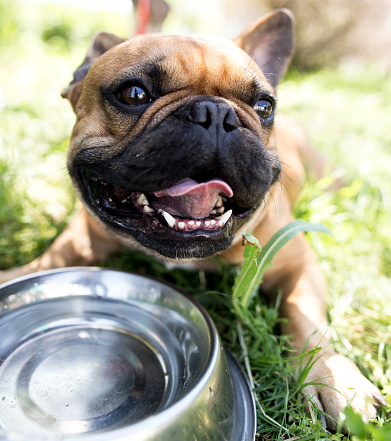Table of Contents
Most of us fill our dog’s water bowl each day but probably have no idea how much water our dogs actually drink. Is it enough? Too much?
Luckily, dogs are pretty good at regulating their own water intake. A healthy dog drinks when she is thirsty and stops when she’s had enough. As long as you provide access to clean, fresh water, they’ll do the rest. You can also perform a simple check for dehydration by lifting a piece of skin on the back of a dog’s neck and letting go. If the skin remains raised and is slow to bounce back, your dog needs more water, whereas a quick return indicates sufficient hydration.
Generally speaking, dogs need about one ounce of water per pound of body weight each day; for reference, a 40-pound dog would need about 5 cups of water daily. Individual water needs may vary slightly based on activity level, diet, health, and the weather.
Your dog might need more water if…
…she’s very active. A dog that’s running around outside all day will need more water, and it’s important to replenish clean water frequently! If the bowl is dry, instinct could lead your dog to other potentially unsafe sources like ponds, or pools.
…it’s hot outside. Just like with humans, warm temperatures increase thirst, so an outdoor water bowl is always a good idea during the summer—even for a low-energy dog who spends the afternoon lounging. Also, always have water on hand when you and your dog are out and about. If you find yourself without, Ollie recommends this hack for transforming a clean poop bag into an impromptu bowl.
…she eats dry food. Dogs on a dry kibble diet tend to need more water not only because the food is dry, but also because some ingredients increase thirst.
…she’s sick or on medication. Dogs who are ill or recovering from illness often need more water, especially if they’re on certain medications that tend to dehydrate or give pups a dry mouth. Dogs with thyroid conditions, Cushing’s disease, or diabetes tend to drink profuse amounts of water. If your dog has been drinking (and urinating) in excess, call your veterinarian for guidance.

…she’s a mama or a puppy. Puppies and dogs who are nursing or pregnant require more water to support their growing and changing bodies.
Your dog might need less water if…
…she’s on a wet food diet. Since there is more water in the wet food itself, your dog will probably be less thirsty.
…your dog snacks on fruits or vegetables. Fresh produce has a high water content that helps keep your dog hydrated.
…your dog has a low activity level and stays indoors all day. Air conditioning and a soft spot on the sofa make for a less thirsty dog.
Remember: If your pup seems to drink water excessively, contact your veterinarian because it could indicate an underlying health problem.
The content is not intended to be a substitute for professional veterinarian advice, diagnosis, or treatment. Always seek the advice of your veterinarian or other qualified health provider with any questions you may have regarding a medical diagnosis, condition, or treatment options.
This article was adapted from the Ollie blog. Ollie delivers freshly made human-grade meals to dogs across the country, tailoring the recipes to their nutritional needs. Want to try it? Go to myollie.com to access a special 50% off discount on your first box.









